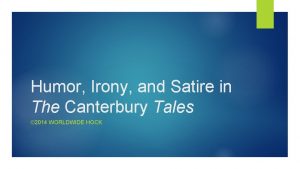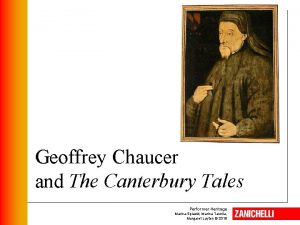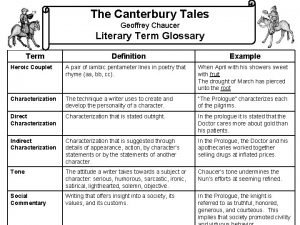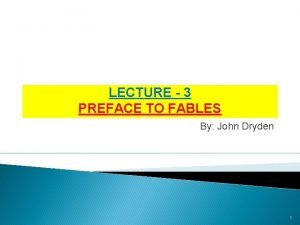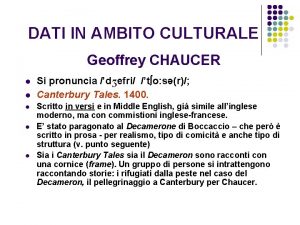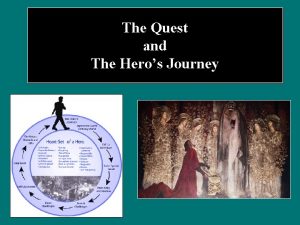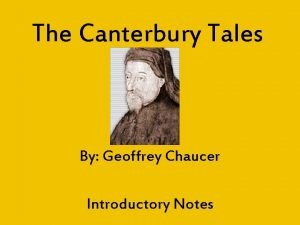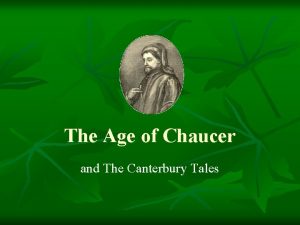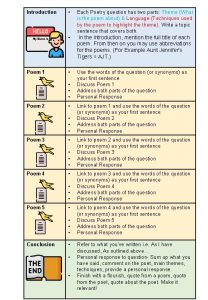Model Chaucer Poem Presentation Title of Poem To










- Slides: 10

Model: Chaucer Poem. Presentation Title of Poem: “To His Scribe Adam”

Required Sections of the Project • • • Meaning/Significance/Theme Historical Significance Paraphrase Graphic Literary Terms/Devices

Meaning/Significance/Theme • Meaning: Chaucer is poking fun at his less-thanadequate scribe, Adam. He is jokingly wishing that Adam gets dandruff as a consequence for his shoddy work on copying Chaucer’s poems. • Significance: Chaucer is letting us know about a quotidian annoyance in his life: his inept scribe. We also learn a little about the life of a successful poet: he would be able to hire a scribe to help him to copy his works. • Theme: One should be careful with his/her work, or else be subject to ridicule and curses!

History of Poem/ Historical Significance: • Once Chaucer become more well known, and successful he paid a scribe to copy his writing to sell to those rich folk • Chaucer (1340? -1400) lived in a time before the printing press (1476—William Caxton), so poets had to depend on scribes to make copies of their work (or do it themselves!) • Boece is: Ancius Manlius Torquatus Severinus Boethius; Chaucer translated Boethius’s work, The Consolation of Philosophy, from Latin to Middle English • Troilus and Criseide is one of Chaucer’s most famous epic poems (Chaucer referred to this)

Paraphrase (6 lines minimum) • Adam scrivain, if evere it thee bifalle • Boece or Troilus for to written new • Under thy long lokkes thou moste have the • scalle, But after my making thou write more trewe, • • So ofte a day I moot thy werk renew, • I must redo your work so often, It to correcte, and eek to rubbe and scrape • To correct it, and also to rub and erase: And al is thurgh thy necligence and rape • This is because of your negligence and haste. • • • Scribe Adam, if you ever choose To rewrite Boece or Troilus all over again May you get dandruff under your long locks of hair You need to write my works more correctly

Graphic to Accompany Poem

Literary Terms in My Poem (4 literary terms) • Conflict (1) – The narrator and the scribe are engaged in a conflict because of the scribe’s shoddy work • Rhyme Scheme (1) – The rhyme scheme is ABABBCC, which is an unusual rhyme scheme for English; usually the rhymes are in a more predictable pattern, but it is in the same style as his other more serious work, Troilus and Criseyde

More Literary Terms in My Poem • Imagery (1) – Chaucer uses visual and tactile (touch) imagery, when talking about the dandruff that he wishes that the scribe would get as a punishment for his crummy work. By using this imagery, Chaucer suggests an itchy scalp, causing the reader to “feel” the “curse” of having the scalle. • Alliteration (2) – (repeated consonant beginning sounds in a line) – Line 3: “Long lokkes” = Chaucer chooses to describe Adam’s long hair as “long locks, ” making for a pleasing mental picture, and a pleasing auditory sensation.

Even More Literary Terms in My Poem • Juxtaposition (2) – Placement of 2 dissimilar themes, characters, phrases, words, or situations next to one another – On line 3, Chaucer juxtaposes the “long lokkes” with the “scalle; ” at first, Chaucer lulls the reader into a feeling of luxurious comfort, and then he “pulls the rug out” from under the reader, by juxtaposing the presence of the hair with itchy, unpleasant dandruff. This causes a humorous, if uncomfortable, reaction on the part of the reader • Synecdoche (3) – when a part or portion of something represents the whole item or idea; or a whole is standing in for a part of something – Chaucer mentions “Troilus” in this little poem, which is an example of synecdoche, considering that the entire title of the poem is Troilus and Criseide. He likely shortens the title in order to fit the meter, but Chaucer perhaps Chaucer is implying that Adam is such a bad scribe that he doesn’t even write the titles of Chaucer’s work correctly, leaving them incomplete.

